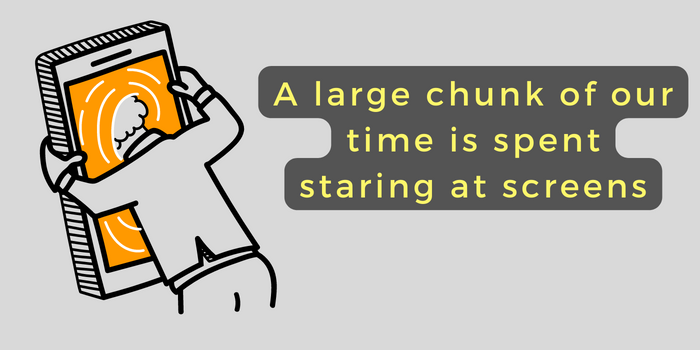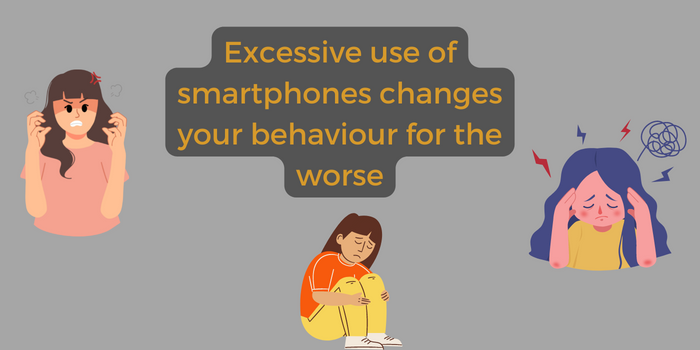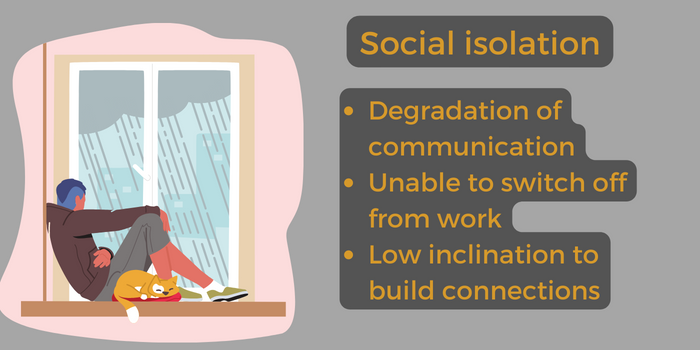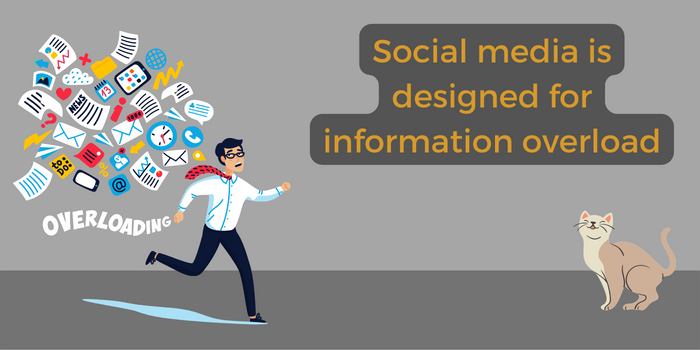From ordering biryani on Swiggy when hungry to swiping right on Tinder to find a partner, the internet has completely changed the way we live.
We communicate differently, we learn differently, we participate in society differently. Things are drastically different from how it used to be even two decades ago.
Have you noticed how things have changed?
In your own life, you may have seen this difference in the way you think and work. It has definitely been my personal experience. I used to find it easy to read for several hours and immerse myself in the plot of a book, but now that sort of deep immersion seems much harder.
The internet itself has transformed from a niche government tool (how it started) to the gargantuan interconnected network that we see today. Then as social media sites emerged, it ushered in a new era and way of human interaction. Never before in the history of humankind have we enjoyed this level of accessibility and ability to communicate.
I love how the internet has contributed to our lives. Just like anyone else, I rely heavily on the ease and convenience of using mobile devices and doing things online, and I’m grateful for the instant connectivity and access to anyone in the world.
This kind of online social networking should have built better relationships, deeper connections, and happier lives. But that’s not the case. Instead, what has happened is quite the contrary.
Let me be clear. Modern digital technology is a marvel. We are lucky to be living in a time like this and we must utilize technology to the fullest extent. But you don’t have to be a luddite to see that it has some negative impact as well.
So what happened? Is there anything we can do about it?
Even as we celebrate and benefit from technology, let us also acknowledge and understand its dark side, because if we ignore it, it will be at our peril.
In this series of articles, we will explore these topics in greater detail.
The internet constantly demands our attention
The internet has become such a ubiquitous and integral part of our everyday life that it constantly demands our attention, practically every waking moment.
A large chunk of our time is spent staring at a screen. We wake up looking at our smartphones, at work we’re staring at our laptops, till we go to bed again with our smartphones.
Throughout the day, we jump to respond to our devices pinging with notifications. We’re always on, but never present in the moment.
As we got comfortable with this new normal of constant distractions, we lost the ability to tolerate even the smallest amount of boredom.
We got sucked into mindless consumption and knee jerk reactions, thus becoming incapable of meaningful work or deep thinking. Our attention span shrank and we lost the ability to focus.
Surge of mental health issues like anxiety and depression
Between 2007 to 2016, adult ADHD diagnoses skyrocketed by 123% in the US alone [1]. This was the time when social media emerged and smartphones became commonplace.
Coincidence? Not likely.
A study on 15-16 year olds published in the Journal of American Medical Association found “significant association between higher frequency of modern digital media use and subsequent symptoms of ADHD” [2].
A study conducted in school and college children in Assam found that internet addiction has a significant association with stress, anxiety, and depression [3].
In the case of at-risk adolescents, on the days that they used their devices frequently, there was an increase in ADHD-like symptoms and other behavioural problems [4].
The idea that increased screen time can be damaging to children and adolescents is not new. But it’s not just kids, adults are equally susceptible.
The more you use technology, the more your behaviour changes for the worse.
Researchers are proposing that internet addiction be included as a new clinical disorder in the Diagnostic and Statistical Manual of Mental Disorders, alongside other newer behavioural addiction issues like gaming or gambling disorder.
Addiction may seem like a strong word, but let’s call it what it is.
When mental health professionals consider problematic internet usage as something worthy of being considered as a clinical disorder, we must understand how serious the issue is.
Social isolation and lack of connectedness
It’s ironic that a technology that connects the whole world and allows instant access to anyone in any corner of the world also becomes the reason for social isolation.
Degradation in the quality of communication
Communication – sometimes even among members of the same family – is now via a quick WhatsApp message.
A PEW study found that 25% of married couples texted each other even while they were together at home at the same time [5]. The same study found extensive time online to be a source of tension among couples, where they experience the degrading of intimacy, and feeling of dissatisfaction as the partner was distracted by something online even when spending time together.
Burnout at work and withdrawal from real life relationships
Technology makes it possible for you to be always available. So unfortunately, even after you leave the office, your work never leaves you.
The boss can (and they often do) call you during the weekend and ask you to prepare a presentation for the meeting on Monday. You don’t want to displease the boss, so you oblige.
Many workplaces today demand instant response to Slack notifications and emails. So you spend most of your day doing just that.
These things can quickly lead to high stress and burnout, no time to go out for face-to-face socializing, and even withdrawal from important real life relationships.
Feelings of loneliness
Extensive usage of social media is correlated with social isolation and higher feelings of loneliness. A 2020 research found that Lebanese people who are highly active on social media sites are also lonely [6].
When you feel isolated, you’re even less inclined to engage with others and build connections. This further amplifies the feeling of loneliness.
Loneliness is also a significant predictor of poor health and sleep fragmentation [7]. We’re social beings who need to feel secure in our social environment in order to rest our mind and sleep well.
Limit social media to feel less lonely
A study at the University of Pennsylvania suggests limiting social media usage to just 30 minutes a day to notice significant improvement in mental well-being [8].
The study was done on 143 undergraduates who experienced less loneliness and depression after limiting their Facebook, Instagram, and Snapchat usage to not more than 30 minutes a day.
Researchers also found that simply by being mindful of their own screen time via self-monitoring, the students experienced a reduction in anxiety and fear of missing out.
Social media is great to be able to connect with friends – but think of it as a snack with low nutritional value. A diet filled with hyper-palatable but low-nutrition foods will undoubtedly be disastrous to health.
Indulge, but in moderation.
Information overload and cognitive overwhelm
How do you check how the stock market is doing?
What about learning how to code?
Latest movie review?
For all this and more, we turn to Google.
Search for anything on Google and it dumps thousands of pages of information. Not too long ago, such access to information was unheard of.
While instant access to information is wonderful, the quality and relevance also matter.
Having too much information paralyzes you. You feel overwhelmed and not in control.
This can lead to feelings of inadequacy at work, lower job satisfaction, and higher stress.
There is a name for this feeling of stress and overwhelm. It is called technostress, which is the stress experienced by employees as they use higher levels of information and communication technology [9].
Social media is designed for information overload
Social media is designed in a way that it naturally causes information overload.
Sasaki et al. found that the more the number of Twitter friends you have, the higher the risk of information overload [10]. When you have many friends online, there are many potential sources of information and people that you have to keep up with.
The whole idea of any social platform is about pushing a continuous stream of content produced by companies (ads), media (news), and by regular users (your vacation pics).
You’re expected to keep pace with this overflow.
Who posted what? What did you like or comment on? Who liked and commented on your posts?
What’s happening with the world? Is the economy going to collapse? World War III?
Aargh!
Social media companies thrive on this surge of dopamine and adrenaline.
Think about it. Facebook and Instagram want users to spend as much time as possible on their platform, so they give you an infinite newsfeed with never ending information. Each new refresh of the newsfeed gives you a fresh dopamine hit.
By design, an infinite newsfeed is impossible to keep up with. And on top of that, you have FOMO or the fear of missing out because you’re not able to consume it all. Talk about a double whammy.
Degradation of focus and attention
Johann Hari wrote in The Guardian that your attention didn’t collapse, it was stolen.
What we are experiencing is a fracturing of self, where we progressively lose our ability to pay attention or concentrate on anything meaningful. Frequent distractions and lack of focus have a catastrophic impact on our productivity, our memory, and quality of life.
How long has it been since you lost yourself in a book? How long since you even picked one up and got to the last page?
Nicholas Carr, author of The Shallows, once wrote about how it used to be easy to immerse himself in a book. But now he gets fidgety, he loses his attention, and looks for something else to do. Deep reading is no longer possible.
At HabitStrong, we have a Book Reading Club – a free Telegram community where people share their reading updates and stay on track with their daily reading habit. I remember a time when our parents used to yell at us for staying up late to read under the blankets. Now we need support mechanisms like a reading club to encourage us to read.
A seemingly cogent response to our poor reading habits is that we are still absorbing information via podcasts and online articles. Granted that podcasts and articles are great, but do we choose them because they are better or because we have lost the ability to do the sufficient attentional work that it requires to read a book?
Reading requires focus and the ability to plough through the initial few pages.
The internet has altered our mental habits to such a degree we find it difficult to pay attention to a book or a lengthy article, and instead look for something we can quickly skim.
Continuous partial attention and cognitive switching penalty
People check their smartphones once every 12 minutes, according to a report from UK’s telecom regulator [11].
We are in a state of continuous partial attention. We’re always on, always alert, constantly scanning the environment for anything that may be relevant, but never giving our full attention to what we’re doing now.
This constant vigilance makes you want to check the phone often, soothing the itch temporarily. Then the whole cycle repeats.
Now, consider this situation at work.
You’re working on something and your inbox shows an email from the boss asking for an update. As soon as you start to type a response, the phone chimes notifying you of fresh pictures of your cute nephew. By the time you get back to work after typing an appropriate comment, your co-worker drops in for a favour. After a long chat he’s gone, but now you have no clue what you need to do next and you’re left juggling 20 things at once.
When you keep switching your attention frequently like this, it has a severe penalty on productivity. It is called the Cognitive Switching Penalty which is basically the extra cognitive load that your brain must process when switching from one context to another.
Frequent context switching leads to lower productivity, lower cognitive functioning, diminished energy levels, and priorities that are all muddled up.
After only 20 minutes of interrupted performance, people reported significantly higher levels of stress and frustration [12].
Can you relate?
This is what working professionals across the world are struggling with. But the good thing is that we can adapt and build new behaviours that can help us rise above these distractions.
But how did this situation come about, and that too within a span of just 20 years?
It is no coincidence – your attention now is a valuable commodity for the attention economy. Hari was right. Our attention was stolen.
In the next article, we will explore how we are all victims of the attention economy and how it has affected the wiring of our brain.
***
Sources
[1] https://www.theguardian.com/society/2022/jun/02/tiktok-trends-or-the-pandemic-whats-behind-the-rise-in-adhd-diagnoses#:~:text=The%20steady%20climb%20of%20juvenile,in%20child%20and%20adolescent%20cases.
[2] Ra CK, Cho J, Stone MD, et al. Association of Digital Media Use With Subsequent Symptoms of Attention-Deficit/Hyperactivity Disorder Among Adolescents. JAMA. 2018;320(3):255–263.https://jamanetwork.com/journals/jama/article-abstract/2687861
[3] Saikia AM, Das J, Barman P, Bharali MD. Internet Addiction and its Relationships with Depression, Anxiety, and Stress in Urban Adolescents of Kamrup District, Assam. J Family Community Med. 2019 May-Aug;26(2):108-112. https://www.ncbi.nlm.nih.gov/pmc/articles/PMC6515762/
[4] https://today.duke.edu/2017/05/more-technology-use-linked-mental-health-issues-risk-adolescents
[5] https://www.pewresearch.org/internet/2014/02/11/couples-the-internet-and-social-media/
[6] Youssef, L., Hallit, R., Kheir, N. et al. Social media use disorder and loneliness: any association between the two? Results of a cross-sectional study among Lebanese adults. BMC Psychol 8, 56 (2020). https://bmcpsychology.biomedcentral.com/articles/10.1186/s40359-020-00421-5
[7] Kurina LM, Knutson KL, Hawkley LC, Cacioppo JT, Lauderdale DS, Ober C. Loneliness is associated with sleep fragmentation in a communal society. Sleep. 2011 Nov 1;34(11):1519-26. https://pubmed.ncbi.nlm.nih.gov/22043123/
[8] No More FOMO: Limiting Social Media Decreases Loneliness and Depression
Melissa G. Hunt, Rachel Marx, Courtney Lipson and Jordyn Young
https://guilfordjournals.com/doi/abs/10.1521/jscp.2018.37.10.751
[9] Bondanini G, Giorgi G, Ariza-Montes A, Vega-Muñoz A, Andreucci-Annunziata P. Technostress Dark Side of Technology in the Workplace: A Scientometric Analysis. Int J Environ Res Public Health. 2020 Oct 30;17(21):8013.
https://www.ncbi.nlm.nih.gov/pmc/articles/PMC7662498/
[10]https://www.researchgate.net/publication/276173904_The_anatomy_of_tweet_overload_How_number_of_tweets_received_number_of_friends_and_egocentric_network_density_affect_perceived_information_overload
[11] https://www.ofcom.org.uk/__data/assets/pdf_file/0022/117256/CMR-2018-narrative-report.pdf
[12] The Cost of Interrupted Work: More Speed and Stress
Gloria Mark, Daniela Gudith and Ulrich Klocke
https://www.ics.uci.edu/~gmark/chi08-mark.pdf




